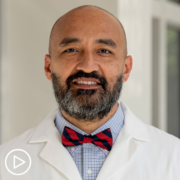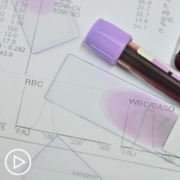How Is MGUS Monitored?
How Is MGUS Monitored? from Patient Empowerment Network on Vimeo.
Myeloma expert Dr. Irene Ghobrial discusses how patients with monoclonal gammopathy of undetermined significance (MGUS) are monitored over time and shares an update on research being conducted to learn more about this myeloma precursor condition.
Dr. Irene Ghobrial is Director of the Clinical Investigator Research Program at Dana-Farber Cancer Institute and Professor of Medicine at Harvard Medical School. Learn more about Dr. Ghobrial.
Related Programs:

Understanding MGUS & Smoldering Myeloma: What’s the Difference? |

|

What Experts Are Learning About the Hereditary Risk of Myeloma |
Transcript:
Katherine Banwell:
Dr. Ghobrial, how are people with MGUS monitored?
Dr. Irene Ghobrial:
Yes, so how do we even diagnose them, right? It’s a big question because it’s incidentally found. Someone will go to their primary care doctor and have a little bit of a high protein or slight anemia, and it may not be related, and then their doctor will check for serum protein electrophoresis, and that’s pure luck. We want to take away luck from this equation. We want to take away chance from this equation.
And we want to start screening people who are at risk, and we are doing that with the PROMISE study. It’s online available to everyone nationwide, international now, where you can sign up on promisestudy.org and try to ask the question that we do for you research level, the serum protein electrophoresis, and a new test called mass spectrometry that is much more sensitive than SPEP to find it.
Now, once we find MGUS, we want to know what is my own personal risk of progressing to myeloma? Because I could be 30 years old with MGUS, and likely I will progress to myeloma in the next 10 years, 20 years, and by the time I’m age 60, I would have been diagnosed with myeloma. Just a true case in many, many people. If people are diagnosed today with myeloma, they are going to their doctor because they had back pain or anemia, and they are diagnosed with myeloma. In almost all of the cases, they would have had MGUS and smoldering, but they didn’t know about it three years ago, four years ago because they never got tested for it.
So, we want to change that completely and become proactive rather than being reactive and waiting for symptoms to happen. Once you have MGUS or smoldering, because we don’t know, we start looking for all of the things to help us identify your risk of progression. So, we look at the height of your M-spike. Is it small or big? And then we in many cases say okay, maybe you need a bone marrow biopsy if your M-spike is a little bit on the higher side because we don’t want to miss smoldering myeloma, which will change the prognosis.
And then we start looking at do you have anemia? Do you have kidney failure? Do you have any of the other things that may predict that you may be actually going into myeloma?
We also look at it more as a movie rather than as a snapshot, rather than a picture. If your M-spike is changing or your light chain is changing every three months, every six months, that’s an indicator that the cancer cells are doing something. They’re working in there and growing, and that’s why they’re increasing the M-spike and the light chain.
And that evolving number is actually a very big predictor of telling us that there is a risk of progressing. Those are all clinical markers that we can do. When we look at the FISH, which we talked about, we can tell the certain markers are chromosomal changes that tell you that those cancer cells want to grow a little bit faster. So, 1q abnormality, 4;14, 14;16, 17p, all of those have been shown that when you have them, the cancer cells are not just sitting around and doing nothing. They’re actually starting to grow, and we want to catch them and understand what is the biology of the disease rather than just how many cancer cells you have.
We do a lot of research level, and potentially now we’re going to give them back to the patients as clinical level, where we can give you more information about that prediction of your risk of progression. One of my colleagues calls it predicting the hurricane. We know that the hurricane will happen, and it’s a question of how precise could you be? We’re the Weather Channel men here.
And we could be very precise and tell you it’s going to hit Miami at 2:00 in the afternoon tomorrow, and you could be prepared for it and get out of there. Or, you could be completely unprepared because we were not very accurate in our prediction and tell you it may hit the whole East Coast in the next two weeks. That’s not accuracy. So, we want to be more accurate in our prediction of myeloma because one person will never develop myeloma and can go have fun and enjoy life and not be worried and anxious about their risk, and another person we might say let’s watch you more carefully, or let’s think of interception preventing things.
So, we do things called next-generation sequencing, taking all of those small numbers of cancer cells, even as little as single cells, and we can do whole genome sequencing and give back that information.
We look at the immune cells and give back that information. We can do mass spectrometry. And with Betsy and Omar, we’re doing more and more tests so that when we have this prediction model, circulating tumor cells and so on, we can be more accurate in giving you that prediction.
And help you make the next decision of are we watching carefully, are we preventing and intervening with behavior modification with other things? Are we intervening with therapy to intercept the disease?
Katherine Banwell:
When are more in-depth tests necessary?
Dr. Irene Ghobrial:
It depends, of course, on everything. I would probably say for every patient, it is a unique discussion. Some patients will tell me, “Let’s watch again in three to six months, and then I will do more testing,” and some patients want to know everything immediately. And we have those discussions with every patient, and we tailor our therapy as well as our diagnostics workup with every patient, depending on how much they want to know, how much their risk is, and how much they want to be involved in that discussion of how much to prevent myeloma.










